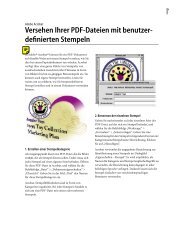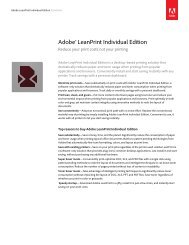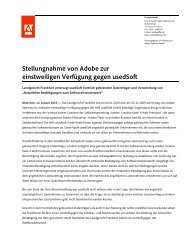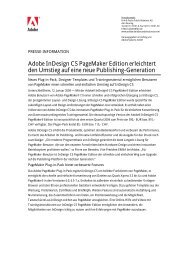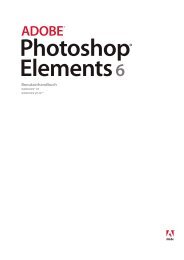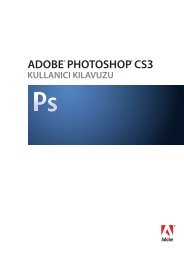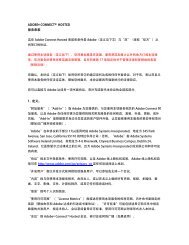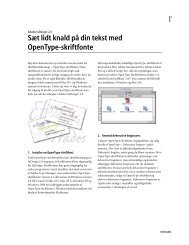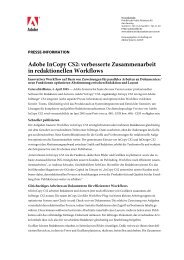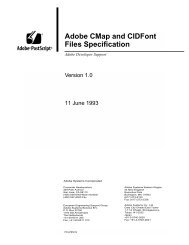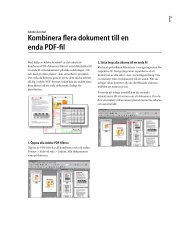- Page 1 and 2: PostScript ® LANGUAGE REFERENCE th
- Page 3 and 4: Preface xiii iii Contents Chapter 1
- Page 5: Appendix B: Implementation Limits 7
- Page 8 and 9: Contents 5.1 Results of Example 5.2
- Page 10 and 11: Contents x 4.6 Entries in a CIEBase
- Page 13: xiii Preface IN THE 1980S, ADOBE DE
- Page 16 and 17: CHAPTER 1 2 Introduction • A gene
- Page 18 and 19: CHAPTER 1 4 Introduction • Chapte
- Page 20 and 21: CHAPTER 1 1.3 LanguageLevel 3 Overv
- Page 22 and 23: CHAPTER 1 8 Introduction are design
- Page 24 and 25: CHAPTER 1 10 Introduction However,
- Page 28 and 29: CHAPTER 2 2.3.1 Imaging Model 14 Ba
- Page 30 and 31: CHAPTER 2 16 Basic Ideas applicatio
- Page 32 and 33: CHAPTER 2 18 Basic Ideas The script
- Page 34 and 35: CHAPTER 2 20 Basic Ideas interprete
- Page 37 and 38: 23 CHAPTER 3 3Language SYNTAX, DATA
- Page 39 and 40: 3.2 25 Syntax The interpreter can s
- Page 41 and 42: 3.2 27 TABLE 3.1 White-space charac
- Page 43 and 44: 3.2 Strings There are three convent
- Page 45 and 46: 3.2 31 Syntax If the final digit of
- Page 47 and 48: 3.2 33 Syntax produces a single pro
- Page 49 and 50: 3.3 35 Data Types and Objects modif
- Page 51 and 52: 3.3 Access 37 Data Types and Object
- Page 53 and 54: 3.3 39 Data Types and Objects The P
- Page 55 and 56: 3.3 41 Data Types and Objects Names
- Page 57 and 58: 3.3 43 Data Types and Objects Opera
- Page 59 and 60: 3.4 3.3.15 Other Object Types 45 St
- Page 61 and 62: 3.5 47 Execution The interpreter fi
- Page 63 and 64: 3.5 49 Execution (pushed on the ope
- Page 65 and 66: 3.6 51 Overview of Basic Operators
- Page 67 and 68: 3.6 53 Overview of Basic Operators
- Page 69 and 70: 3.6 The following operators apply o
- Page 71 and 72: 3.7 57 Memory Management the curren
- Page 73 and 74: 3.7 59 Memory Management jects, res
- Page 75 and 76: 3.7 61 Memory Management ldict /a l
- Page 77 and 78:
3.7 3.7.4 Garbage Collection 63 Mem
- Page 79 and 80:
3.7 3.7.5 Standard and User-Defined
- Page 81 and 82:
3.7 67 Memory Management lates chan
- Page 83 and 84:
3.7 69 Memory Management A job begi
- Page 85 and 86:
3.7 71 Memory Management saved VM s
- Page 87 and 88:
3.8 73 File Input and Output quence
- Page 89 and 90:
3.8 75 File Input and Output End-of
- Page 91 and 92:
3.8 3.8.2 Named Files 77 File Input
- Page 93 and 94:
3.8 Creating and Closing a File Obj
- Page 95 and 96:
3.8 For example, the statements (%s
- Page 97 and 98:
3.8 83 File Input and Output Encodi
- Page 99 and 100:
3.8 85 File Input and Output these
- Page 101 and 102:
3.9 87 Named Resources them. The se
- Page 103 and 104:
3.9 89 Named Resources The findreso
- Page 105 and 106:
3.9 91 TABLE 3.7 Regular resources
- Page 107 and 108:
3.9 Font 93 Named Resources Instanc
- Page 109 and 110:
3.9 • ISOLatin1Encoding, whose va
- Page 111 and 112:
3.9 IdiomSet 97 Named Resources Ins
- Page 113 and 114:
3.9 99 Named Resources keys; if an
- Page 115 and 116:
3.9 KEY TYPE VALUE 101 TABLE 3.11 E
- Page 117 and 118:
3.9 103 Named Resources serts an In
- Page 119 and 120:
3.9 105 Named Resources For most re
- Page 121 and 122:
3.10 107 Functions Each function de
- Page 123 and 124:
3.10 109 Functions In addition to t
- Page 125 and 126:
3.10 111 Functions error will occur
- Page 127 and 128:
3.10 113 TABLE 3.14 Additional entr
- Page 129 and 130:
3.11 115 Errors Errors are handled
- Page 131 and 132:
3.12 117 Early Name Binding records
- Page 133 and 134:
3.12 119 Early Name Binding but can
- Page 135 and 136:
3.12 121 Early Name Binding The tem
- Page 137 and 138:
3.13 123 Filtered Files Details beh
- Page 139 and 140:
3.13 125 Filtered Files Details pro
- Page 141 and 142:
3.13 127 Filtered Files Details dec
- Page 143 and 144:
3.13 129 Filtered Files Details cre
- Page 145 and 146:
3.13 131 Filtered Files Details The
- Page 147 and 148:
3.13 LZWEncode Filter target /LZWEn
- Page 149 and 150:
3.13 135 Filtered Files Details Whe
- Page 151 and 152:
3.13 137 Filtered Files Details ord
- Page 153 and 154:
3.13 139 Filtered Files Details com
- Page 155 and 156:
3.13 141 Filtered Files Details TAB
- Page 157 and 158:
3.13 143 Filtered Files Details Unp
- Page 159 and 160:
3.13 145 Filtered Files Details ima
- Page 161 and 162:
3.13 147 Filtered Files Details Not
- Page 163 and 164:
3.13 149 Filtered Files Details Eac
- Page 165 and 166:
3.13 151 Filtered Files Details to
- Page 167 and 168:
3.13 ReusableStreamDecode Filter 15
- Page 169 and 170:
3.13 155 Filtered Files Details TAB
- Page 171 and 172:
3.14 157 Binary Encoding Details Us
- Page 173 and 174:
3.14 159 Binary Encoding Details 13
- Page 175 and 176:
3.14 Homogeneous Number Arrays 161
- Page 177 and 178:
3.14 3.14.2 Binary Object Sequences
- Page 179 and 180:
3.14 165 Binary Encoding Details 4.
- Page 181 and 182:
3.14 167 Binary Encoding Details Fo
- Page 183 and 184:
3.14 169 Binary Encoding Details In
- Page 185 and 186:
3.14 3.14.5 Encoded Number Strings
- Page 187 and 188:
3.14 173 Binary Encoding Details Th
- Page 189 and 190:
175 CHAPTER 4 4Graphics THE POSTSCR
- Page 191 and 192:
4.1 177 Imaging Model invoking the
- Page 193 and 194:
4.2 179 Graphics State • The curr
- Page 195 and 196:
4.2 181 Graphics State flatness num
- Page 197 and 198:
4.3 183 Coordinate Systems and Tran
- Page 199 and 200:
4.3 185 Coordinate Systems and Tran
- Page 201 and 202:
4.3 187 Coordinate Systems and Tran
- Page 203 and 204:
4.4 189 Path Construction transform
- Page 205 and 206:
4.4 191 Path Construction A program
- Page 207 and 208:
4.5 193 The following operators man
- Page 209 and 210:
4.5 195 Painting sionally useful fo
- Page 211 and 212:
4.6 197 User Paths stroke) would ca
- Page 213 and 214:
4.6 199 User Paths Note: The operat
- Page 215 and 216:
4.6 201 TABLE 4.3 Operation codes f
- Page 217 and 218:
4.6 Example 4.5 /Circle1 { ucache -
- Page 219 and 220:
4.6 205 User Paths ation (stroke, f
- Page 221 and 222:
4.7 207 Forms These rules permit th
- Page 223 and 224:
4.7 209 Forms Whenever execform nee
- Page 225 and 226:
4.8 211 Color Spaces In LanguageLev
- Page 227 and 228:
X, Y, Z R, G, B C, M, Y, K gray tin
- Page 229 and 230:
4.8 215 Color Spaces • setcolor s
- Page 231 and 232:
4.8 DeviceRGB Color Space 217 Color
- Page 233 and 234:
4.8 219 Color Spaces 1.0, where 0.0
- Page 235 and 236:
4.8 221 Color Spaces where name is
- Page 237 and 238:
4.8 KEY TYPE VALUE 223 TABLE 4.5 En
- Page 239 and 240:
4.8 225 Color Spaces put device. In
- Page 241 and 242:
4.8 227 Color Spaces Example 4.11 e
- Page 243 and 244:
4.8 KEY TYPE VALUE A 229 DecodeA De
- Page 245 and 246:
4.8 Example 4.12 231 [ /CIEBasedA >
- Page 247 and 248:
4.8 233 Color Spaces The parameters
- Page 249 and 250:
4.8 235 Color Spaces TABLE 4.8 Addi
- Page 251 and 252:
4.8 /Table [15 30 25 20 [ [ ] < …
- Page 253 and 254:
4.8 239 Color Spaces peated indefin
- Page 255 and 256:
4.8 241 Color Spaces component valu
- Page 257 and 258:
4.8 243 Color Spaces Note: To use a
- Page 259 and 260:
4.8 245 Color Spaces space; the tin
- Page 261 and 262:
4.8 Example 4.18 [ /Indexed [ /Devi
- Page 263 and 264:
4.9 249 Patterns Note: The ability
- Page 265 and 266:
4.9 251 Patterns makepattern may co
- Page 267 and 268:
4.9 253 Patterns components of the
- Page 269 and 270:
4.9 255 Patterns Example 4.21 defin
- Page 271 and 272:
4.9 257 Patterns background shows t
- Page 273 and 274:
4.9 259 FIGURE 4.11 Output from Exa
- Page 275 and 276:
4.9 261 Patterns Note: Patterns def
- Page 277 and 278:
4.9 263 Patterns Some types of shad
- Page 279 and 280:
4.9 Shading Types 265 Patterns In a
- Page 281 and 282:
4.9 267 Patterns of the shading dic
- Page 283 and 284:
4.9 269 Patterns which varies linea
- Page 285 and 286:
4.9 271 Patterns Function dictionar
- Page 287 and 288:
4.9 273 Patterns Complex shapes can
- Page 289 and 290:
4.9 (i, j) (i, j+1) (i+1, j) (i+1,
- Page 291 and 292:
4.9 Type 6 Shadings (Coons Patch Me
- Page 293 and 294:
4.9 279 Patterns patch boundary if,
- Page 295 and 296:
4.9 281 Patterns As in free-form tr
- Page 297 and 298:
4.9 283 f = 1 x 5 y 5 x 6 y 6 x 7 y
- Page 299 and 300:
4.9 285 Patterns where p ij is the
- Page 301 and 302:
4.9 287 TABLE 4.19 Data values in a
- Page 303 and 304:
4.10 289 Images • A few LanguageL
- Page 305 and 306:
4.10 291 Images Each row of the sou
- Page 307 and 308:
4.10 Single-component image Data so
- Page 309 and 310:
4.10 295 Images Although it is poss
- Page 311 and 312:
4.10 297 Images sample and the inte
- Page 313 and 314:
4.10 299 Images The following secti
- Page 315 and 316:
4.10 301 Images range 0.0 to 1.0. I
- Page 317 and 318:
4.10 303 Images • The five-operan
- Page 319 and 320:
4.10 KEY TYPE VALUE 305 Images nent
- Page 321 and 322:
4.10 307 Images entry in the image
- Page 323 and 324:
4.10 Monochrome Image 309 Images Ex
- Page 325:
4.10 Image Dictionary 311 Images Ex
- Page 328 and 329:
CHAPTER 5 314 Fonts computer typogr
- Page 330 and 331:
CHAPTER 5 316 Fonts current positio
- Page 332 and 333:
CHAPTER 5 318 Fonts makefont), and
- Page 334 and 335:
CHAPTER 5 Example 5.5 /Helvetica fi
- Page 336 and 337:
CHAPTER 5 TYPE DESCRIPTION 322 TABL
- Page 338 and 339:
CHAPTER 5 324 Fonts categories, not
- Page 340 and 341:
CHAPTER 5 326 Fonts UniqueID intege
- Page 342 and 343:
CHAPTER 5 328 Fonts • Some applic
- Page 344 and 345:
CHAPTER 5 330 Fonts Changing an exi
- Page 346 and 347:
CHAPTER 5 332 Fonts bounding box is
- Page 348 and 349:
CHAPTER 5 334 Fonts conventions to
- Page 350 and 351:
CHAPTER 5 336 Fonts available from
- Page 352 and 353:
CHAPTER 5 338 Fonts no direct conne
- Page 354 and 355:
CHAPTER 5 340 Fonts • setcachedev
- Page 356 and 357:
CHAPTER 5 342 /CharProcs 3 dict def
- Page 358 and 359:
CHAPTER 5 FontSet Resources 344 Fon
- Page 360 and 361:
CHAPTER 5 346 Fonts instances. The
- Page 362 and 363:
CHAPTER 5 348 Fonts a Type 1 font w
- Page 364 and 365:
CHAPTER 5 350 Fonts Note: If you cr
- Page 366 and 367:
CHAPTER 5 352 Fonts The execution e
- Page 368 and 369:
CHAPTER 5 354 Fonts The method for
- Page 370 and 371:
CHAPTER 5 356 Fonts If GlyphDirecto
- Page 372 and 373:
CHAPTER 5 358 Fonts one reference t
- Page 374 and 375:
CHAPTER 5 ALGORITHM FMAPTYPE EXPLAN
- Page 376 and 377:
CHAPTER 5 • 9/7 mapping: 362 Fon
- Page 378 and 379:
CHAPTER 5 364 Fonts • If the desc
- Page 380 and 381:
CHAPTER 5 366 Fonts A CMap (charact
- Page 382 and 383:
CHAPTER 5 KEY TYPE VALUE 368 TABLE
- Page 384 and 385:
CHAPTER 5 370 TABLE 5.11 CIDFontTyp
- Page 386 and 387:
CHAPTER 5 372 Fonts tures that cont
- Page 388 and 389:
CHAPTER 5 Metrics2 dictionary (Opti
- Page 390 and 391:
CHAPTER 5 376 Fonts Glyphs,” expl
- Page 392 and 393:
CHAPTER 5 378 Fonts In addition to
- Page 394 and 395:
CHAPTER 5 380 Fonts The results pro
- Page 396 and 397:
CHAPTER 5 382 Fonts moved may conti
- Page 398 and 399:
CHAPTER 5 384 Fonts UIDOffset integ
- Page 400 and 401:
CHAPTER 5 386 /CIDSystemInfo [ 3 di
- Page 402 and 403:
CHAPTER 5 388 Fonts A PostScript pr
- Page 404 and 405:
CHAPTER 5 390 Fonts If a code maps
- Page 406 and 407:
CHAPTER 6 Configuring a page device
- Page 408 and 409:
CHAPTER 6 394 Device Control Even i
- Page 410 and 411:
CHAPTER 6 396 Device Control are pe
- Page 412 and 413:
CHAPTER 6 6.2 Page Device Parameter
- Page 414 and 415:
CHAPTER 6 Media selection is perfor
- Page 416 and 417:
CHAPTER 6 402 Device Control MediaT
- Page 418 and 419:
CHAPTER 6 404 Device Control but th
- Page 420 and 421:
CHAPTER 6 406 Device Control setpag
- Page 422 and 423:
CHAPTER 6 408 The precise effects o
- Page 424 and 425:
CHAPTER 6 410 Device Control the va
- Page 426 and 427:
CHAPTER 6 6.2.2 Roll-Fed Media 412
- Page 428 and 429:
CHAPTER 6 KEY TYPE VALUE 414 TABLE
- Page 430 and 431:
CHAPTER 6 416 Device Control Duplex
- Page 432 and 433:
CHAPTER 6 418 Device Control If the
- Page 434 and 435:
CHAPTER 6 420 Device Control • Wh
- Page 436 and 437:
CHAPTER 6 422 Device Control in Sep
- Page 438 and 439:
CHAPTER 6 424 Device Control Note:
- Page 440 and 441:
CHAPTER 6 426 Device Control Separa
- Page 442 and 443:
CHAPTER 6 428 Device Control tion s
- Page 444 and 445:
CHAPTER 6 430 Device Control state
- Page 446 and 447:
CHAPTER 6 %%Page: 1 1 save … Post
- Page 448 and 449:
CHAPTER 6 434 Device Control • Re
- Page 450 and 451:
CHAPTER 6 436 Device Control tial t
- Page 452 and 453:
CHAPTER 6 438 Device Control pect r
- Page 454 and 455:
CHAPTER 6 440 Device Control Figure
- Page 456 and 457:
CHAPTER 6 442 Device Control Every
- Page 458 and 459:
CHAPTER 6 KEY TYPE VALUE 444 TABLE
- Page 460 and 461:
CHAPTER 6 446 Device Control Note:
- Page 462 and 463:
CHAPTER 6 448 Device Control TrapWi
- Page 464 and 465:
CHAPTER 6 450 Device Control In the
- Page 466 and 467:
CHAPTER 6 452 Device Control A colo
- Page 468 and 469:
CHAPTER 6 454 Device Control • Al
- Page 470 and 471:
CHAPTER 6 456 Device Control HWReso
- Page 472 and 473:
CHAPTER 7 458 Rendering 4. If the d
- Page 474 and 475:
CHAPTER 7 460 Rendering preserve co
- Page 476 and 477:
CHAPTER 7 462 Rendering 2. Adjust t
- Page 478 and 479:
CHAPTER 7 464 Rendering EncodeABC b
- Page 480 and 481:
CHAPTER 7 where 466 Ws = [ X Ws YWs
- Page 482 and 483:
CHAPTER 7 468 Rendering The element
- Page 484 and 485:
CHAPTER 7 RENDERING INTENT DESCRIPT
- Page 486 and 487:
CHAPTER 7 472 Rendering If findcolo
- Page 488 and 489:
CHAPTER 7 474 Rendering Note: These
- Page 490 and 491:
CHAPTER 7 476 Rendering Logically,
- Page 492 and 493:
CHAPTER 7 7.2.5 Conversion to Devic
- Page 494 and 495:
CHAPTER 7 480 Rendering Because the
- Page 496 and 497:
CHAPTER 7 482 Rendering • The set
- Page 498 and 499:
CHAPTER 7 484 Rendering the require
- Page 500 and 501:
CHAPTER 7 486 Rendering The specifi
- Page 502 and 503:
CHAPTER 7 488 Rendering ActualAngle
- Page 504 and 505:
CHAPTER 7 490 Rendering A halftone
- Page 506 and 507:
CHAPTER 7 492 Rendering closes the
- Page 508 and 509:
CHAPTER 7 494 FIGURE 7.4 Halftone c
- Page 510 and 511:
CHAPTER 7 KEY TYPE VALUE 496 TABLE
- Page 512 and 513:
CHAPTER 7 Type 2 and 4 Halftone Dic
- Page 514 and 515:
CHAPTER 7 500 Rendering A type 9 ha
- Page 516 and 517:
CHAPTER 7 502 Rendering Still, it i
- Page 518 and 519:
CHAPTER 7 1 pixel Line width Path R
- Page 520 and 521:
CHAPTER 8 506 Operators Normally, t
- Page 522 and 523:
CHAPTER 8 8.1 Operator Summary Oper
- Page 524 and 525:
CHAPTER 8 Dictionary Operators 510
- Page 526 and 527:
CHAPTER 8 Control Operators 512 Ope
- Page 528 and 529:
CHAPTER 8 Resource Operators 514 Op
- Page 530 and 531:
CHAPTER 8 516 Operators - currentst
- Page 532 and 533:
CHAPTER 8 518 s x s y scale - Scale
- Page 534 and 535:
CHAPTER 8 520 Operators dict image
- Page 536 and 537:
CHAPTER 8 522 Operators name|cid gl
- Page 538 and 539:
CHAPTER 8 8.2 Operator Details [ -
- Page 540 and 541:
CHAPTER 8 = any = - 526 Operators p
- Page 542 and 543:
CHAPTER 8 528 Operators addglyph me
- Page 544 and 545:
CHAPTER 8 arc x y r angle 1 angle 2
- Page 546 and 547:
CHAPTER 8 532 Operators This exampl
- Page 548 and 549:
CHAPTER 8 534 arcto x 1 y 1 x 2 y 2
- Page 550 and 551:
CHAPTER 8 Normal spacing Wide spaci
- Page 552 and 553:
CHAPTER 8 538 Operators beginnotdef
- Page 554 and 555:
CHAPTER 8 cachestatus - cachestatus
- Page 556 and 557:
CHAPTER 8 clip - clip - 542 Operato
- Page 558 and 559:
CHAPTER 8 544 Errors: limitcheck Se
- Page 560 and 561:
CHAPTER 8 546 Operators the equival
- Page 562 and 563:
CHAPTER 8 548 copy any 1 … any n
- Page 564 and 565:
CHAPTER 8 550 Operators variable co
- Page 566 and 567:
CHAPTER 8 552 Operators glyph and d
- Page 568 and 569:
CHAPTER 8 currentcolorscreen - curr
- Page 570 and 571:
CHAPTER 8 currentfile - currentfile
- Page 572 and 573:
CHAPTER 8 558 currentgstate gstate
- Page 574 and 575:
CHAPTER 8 currentmiterlimit - curre
- Page 576 and 577:
CHAPTER 8 562 Operators • If the
- Page 578 and 579:
CHAPTER 8 564 Operators currenttrap
- Page 580 and 581:
CHAPTER 8 cvi num cvi int string cv
- Page 582 and 583:
CHAPTER 8 cvs any string cvs substr
- Page 584 and 585:
CHAPTER 8 570 Operators In Language
- Page 586 and 587:
CHAPTER 8 572 Operators If defineus
- Page 588 and 589:
CHAPTER 8 dictstackoverflow (error)
- Page 590 and 591:
CHAPTER 8 eexec file eexec - string
- Page 592 and 593:
CHAPTER 8 578 Operators endcidrange
- Page 594 and 595:
CHAPTER 8 eofill - eofill - 580 Ope
- Page 596 and 597:
CHAPTER 8 exec any exec - 582 Opera
- Page 598 and 599:
CHAPTER 8 execstackoverflow (error)
- Page 600 and 601:
CHAPTER 8 586 Operators operator qu
- Page 602 and 603:
CHAPTER 8 588 filenameforall templa
- Page 604 and 605:
CHAPTER 8 590 Operators filters do
- Page 606 and 607:
CHAPTER 8 findfont key findfont fon
- Page 608 and 609:
CHAPTER 8 594 Operators The flatten
- Page 610 and 611:
CHAPTER 8 596 for initial increment
- Page 612 and 613:
CHAPTER 8 gcheck any gcheck bool 59
- Page 614 and 615:
CHAPTER 8 600 Operators The returne
- Page 616 and 617:
CHAPTER 8 glyphshow name glyphshow
- Page 618 and 619:
CHAPTER 8 604 Operators The save op
- Page 620 and 621:
CHAPTER 8 606 idtransform dx′ dy
- Page 622 and 623:
CHAPTER 8 608 Operators In Language
- Page 624 and 625:
CHAPTER 8 610 Operators Errors: inv
- Page 626 and 627:
CHAPTER 8 initgraphics - initgraphi
- Page 628 and 629:
CHAPTER 8 internaldict int internal
- Page 630 and 631:
CHAPTER 8 616 inustroke x y userpat
- Page 632 and 633:
CHAPTER 8 618 invertmatrix matrix 1
- Page 634 and 635:
CHAPTER 8 620 Operators When proc i
- Page 636 and 637:
CHAPTER 8 lineto x y lineto - 622 O
- Page 638 and 639:
CHAPTER 8 624 makefont font matrix
- Page 640 and 641:
CHAPTER 8 626 Operators work simila
- Page 642 and 643:
CHAPTER 8 ne any 1 any 2 ne bool 62
- Page 644 and 645:
CHAPTER 8 null nulldevice - null nu
- Page 646 and 647:
CHAPTER 8 pathforall 632 Operators
- Page 648 and 649:
CHAPTER 8 printobject obj tag print
- Page 650 and 651:
CHAPTER 8 636 Examples /ar [5 17 3
- Page 652 and 653:
CHAPTER 8 rangecheck (error) 638 Op
- Page 654 and 655:
CHAPTER 8 640 Operators line feed c
- Page 656 and 657:
CHAPTER 8 642 Operators Assuming wi
- Page 658 and 659:
CHAPTER 8 644 Operators removeall c
- Page 660 and 661:
CHAPTER 8 646 resourceforall templa
- Page 662 and 663:
CHAPTER 8 648 Operators “Resource
- Page 664 and 665:
CHAPTER 8 rlineto dx dy rlineto - 6
- Page 666 and 667:
CHAPTER 8 652 Operators with the ma
- Page 668 and 669:
CHAPTER 8 scale s x s y scale - s x
- Page 670 and 671:
CHAPTER 8 656 Operators Errors: inv
- Page 672 and 673:
CHAPTER 8 658 Operators means that
- Page 674 and 675:
CHAPTER 8 660 Operators current poi
- Page 676 and 677:
CHAPTER 8 662 setcmykcolor cyan mag
- Page 678 and 679:
CHAPTER 8 setcolorscreen redfreq re
- Page 680 and 681:
CHAPTER 8 setcolortransfer redproc
- Page 682 and 683:
CHAPTER 8 668 Operators Permission
- Page 684 and 685:
CHAPTER 8 670 Operators The choice
- Page 686 and 687:
CHAPTER 8 672 Operators or is not s
- Page 688 and 689:
CHAPTER 8 674 Operators 1 Round joi
- Page 690 and 691:
CHAPTER 8 676 Operators decreases.
- Page 692 and 693:
CHAPTER 8 678 Operators When overpr
- Page 694 and 695:
CHAPTER 8 680 Operators If a device
- Page 696 and 697:
CHAPTER 8 682 Operators Frequency a
- Page 698 and 699:
CHAPTER 8 setsystemparams dict sets
- Page 700 and 701:
CHAPTER 8 686 Operators Note that t
- Page 702 and 703:
CHAPTER 8 688 Operators implementat
- Page 704 and 705:
CHAPTER 8 690 Operators Execution o
- Page 706 and 707:
CHAPTER 8 sin angle sin real 692 Op
- Page 708 and 709:
CHAPTER 8 694 Operators ed to provi
- Page 710 and 711:
CHAPTER 8 696 Operators operator. I
- Page 712 and 713:
CHAPTER 8 698 Operators This mechan
- Page 714 and 715:
CHAPTER 8 stroke - stroke - 700 Ope
- Page 716 and 717:
CHAPTER 8 systemdict - systemdict d
- Page 718 and 719:
CHAPTER 8 704 translate t x t y tra
- Page 720 and 721:
CHAPTER 8 typecheck (error) 706 Ope
- Page 722 and 723:
CHAPTER 8 ueofill userpath ueofill
- Page 724 and 725:
CHAPTER 8 710 Operators stance). Se
- Page 726 and 727:
CHAPTER 8 unregistered (error) 712
- Page 728 and 729:
CHAPTER 8 usertime - usertime int 7
- Page 730 and 731:
CHAPTER 8 version - version string
- Page 732 and 733:
CHAPTER 8 718 Operators main consta
- Page 734 and 735:
CHAPTER 8 write file int write - 72
- Page 736 and 737:
CHAPTER 8 xor bool 1 bool 2 xor boo
- Page 739 and 740:
725 APPENDIX A ALanguageLevel Featu
- Page 741 and 742:
A.1 TYPE OF RESOURCE NEW CATEGORIES
- Page 743 and 744:
A.1 729 LanguageLevel 3 Features
- Page 745 and 746:
A.2 A.1.7 Version 2011 Extensions 7
- Page 747 and 748:
A.2 733 setgstate ucache sethalfton
- Page 749:
A.3 A.2.5 Miscellaneous Language Ad
- Page 752 and 753:
APPENDIX B B.1 Typical Limits 738 I
- Page 754 and 755:
APPENDIX B 740 Implementation Limit
- Page 756 and 757:
APPENDIX B 742 Implementation Limit
- Page 759 and 760:
745 APPENDIX C CInterpreter Paramet
- Page 761 and 762:
C.1 747 Properties of User and Syst
- Page 763 and 764:
C.2 749 Defined User and System Par
- Page 765 and 766:
C.2 KEY TYPE VALUE 751 TABLE C.2 Sy
- Page 767 and 768:
C.3 753 Details of User and System
- Page 769 and 770:
C.3 755 Details of User and System
- Page 771 and 772:
C.3 757 Details of User and System
- Page 773 and 774:
C.3 759 Details of User and System
- Page 775 and 776:
761 APPENDIX D DCompatibility Strat
- Page 777 and 778:
D.2 D.2 When to Provide Compatibili
- Page 779 and 780:
D.3 765 Compatibility Techniques Th
- Page 781 and 782:
D.3 D.3.2 Partial Emulation 767 Com
- Page 783 and 784:
D.4 769 Installing Emulations coord
- Page 785:
D.4 771 Installing Emulations The e
- Page 788 and 789:
APPENDIX E 774 Character Sets and E
- Page 790 and 791:
APPENDIX E E.2 Helvetica Family 776
- Page 792 and 793:
APPENDIX E E.4 Symbol Sample Uses 7
- Page 794 and 795:
APPENDIX E 780 Character Sets and E
- Page 796 and 797:
APPENDIX E 782 Character Sets and E
- Page 798 and 799:
APPENDIX E 784 E.6 StandardEncoding
- Page 800 and 801:
APPENDIX E E.8 CE Encoding Vector o
- Page 802 and 803:
APPENDIX E 788 Character Sets and E
- Page 804 and 805:
APPENDIX E E.10 Expert Encoding Vec
- Page 806 and 807:
APPENDIX E E.12 Symbol Character Se
- Page 808 and 809:
APPENDIX E E.13 Symbol Encoding Vec
- Page 810 and 811:
APPENDIX F 796 System Name Encoding
- Page 812 and 813:
APPENDIX F 798 System Name Encoding
- Page 815 and 816:
801 APPENDIX G GOperator Usage Guid
- Page 817 and 818:
803 initgraphics Careful No initmat
- Page 819 and 820:
805 erasepage Disrupts nesting of i
- Page 821 and 822:
807 setgstate must not impose a gra
- Page 823 and 824:
setundercolorremoval See settransfe
- Page 825 and 826:
811 Bibliography SOME DOCUMENTS LIS
- Page 827 and 828:
813 Bibliography • Color Separati
- Page 829:
815 Bibliography Stokes, M., et al.
- Page 832 and 833:
A INDEX abs operator 52, 527 absolu
- Page 834 and 835:
INDEX array(s) (continued) executab
- Page 836 and 837:
INDEX binary (continued) tokens 156
- Page 838 and 839:
INDEX cache (continued) font (conti
- Page 840 and 841:
INDEX circle See arc circular queue
- Page 842 and 843:
INDEX color (continued) specificati
- Page 844 and 845:
INDEX construction (continued) of a
- Page 846 and 847:
INDEX CTM (current transformation m
- Page 848 and 849:
INDEX decoding (continued) binary d
- Page 850 and 851:
INDEX definitions of terms (continu
- Page 852 and 853:
INDEX definitions of terms (continu
- Page 854 and 855:
INDEX dictionaries (continued) erro
- Page 856 and 857:
E INDEX E as real number exponent i
- Page 858 and 859:
INDEX EPS (encapsulated PostScript)
- Page 860 and 861:
INDEX execution (continued) semanti
- Page 862 and 863:
INDEX filters (continued) creating
- Page 864 and 865:
INDEX font(s) (continued) Type 0 (c
- Page 866 and 867:
INDEX generation (continued) machin
- Page 868 and 869:
INDEX guidelines (continued) PaintP
- Page 870 and 871:
INDEX image operator (continued) (e
- Page 872 and 873:
INDEX insideness testing (continued
- Page 874 and 875:
INDEX known operator 54, 619 deprec
- Page 876 and 877:
INDEX luminance representation, CIE
- Page 878 and 879:
INDEX memory See also garbage colle
- Page 880 and 881:
INDEX .notdef character name (conti
- Page 882 and 883:
INDEX operators (continued) boolean
- Page 884 and 885:
INDEX page devices (continued) init
- Page 886 and 887:
INDEX Pattern resource category 95
- Page 888 and 889:
INDEX procedure(s) (continued) as o
- Page 890 and 891:
INDEX record as irrelevant in PostS
- Page 892 and 893:
INDEX resource(s) (continued) HWOpt
- Page 894 and 895:
INDEX right parenthesis ()) \) as A
- Page 896 and 897:
INDEX server (continued) print, as
- Page 898 and 899:
INDEX setup of pages, device initia
- Page 900 and 901:
INDEX stack operator 87, 692 stack(
- Page 902 and 903:
INDEX string(s) (continued) names a
- Page 904 and 905:
INDEX testing See also insideness t
- Page 906 and 907:
INDEX TrappingOrder array as Trappi
- Page 908 and 909:
INDEX user paths (continued) cache
- Page 910 and 911:
INDEX writestring operator 721 EOL





